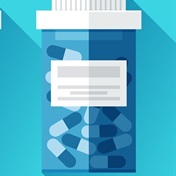Official reports of negative reactions to prescription drugs have increased dramatically over the last decade, according to a new study.
In a US Food and Drug Administration (FDA) database launched in 1969, researchers found that over half the reports of adverse events suspected to be caused by a particular drug or device date from just the past 10 years.
The FDA currently receives about half-a-million reports of health problems or deaths associated with medical products each year.
In 2000, they came in at a rate of nearly five for every 10,000 office visits in which at least one prescription was written. By 2005, that rate had risen to nearly seven per 10,000 visits, according to the new analysis published online today in the Archives of Internal Medicine.
Between 2000 and 2010, the number of reports coming in grew steadily by more than 11% every year. By 2010, they added up to 2.2 million reports - 55% of the entire database total.
Reports not equal
Study author Dr Sheila Weiss-Smith of the University of Maryland in Baltimore cautioned that the number of reports does not equal the true number of negative reactions to drugs.
Manufacturers are required to report to the FDA any health problem they suspect stems from one of their products, but for doctors, patients, lawyers, and anyone else who reports these reactions, it's entirely voluntary, she said.
It's hard to estimate how many negative reactions to drugs actually occur, Dr Weiss-Smith noted.
Some experts suggest official reports represent one-tenth of the number of actual negative reactions, but she said she doesn't trust that figure. "We just don't know. We don't know what percentage of events actually gets reported."
More people taking drugs
She added that it's also difficult to determine why the reports are increasing. The elderly now make up a larger percentage of the population, and they may be more likely to react negatively to drugs, she speculated.
More people are taking drugs, and for longer times, which increases the potential for bad reactions, and negative interactions between drugs, she said.
Often, the number of reports will increase for a particular drug after news articles appear that say it has problems - for instance, the pain reliever Vioxx, which was removed from the market in 2004.
"It's amazing how publicity spurs reporting," she said.
Official documents reviewed
Dr Weiss-Smith and her collaborators reviewed all official reports of negative reactions to brand-name drugs submitted between 2000 and 2009.
During that period, the FDA received 2.2 million entries to its Adverse Event Reporting System (AERS). Among reports that included information about what happened to patients, more than 40% were hospitalised and 15% died.
Some of the drugs most frequently tied to negative reactions were recombinant DNA products, which leave people at greater risk of infections.
Other drugs that topped the list were a diabetes treatment exenatide (Byetta), one for osteoporosis called teriparatide (Forteo), as well as a birth-control patch containing ethinyl estradiol and norelgestromin (Ortho Evra).
(Reuters Health, Alison McCook, March 2011)
Read more:




 Publications
Publications
 Partners
Partners










